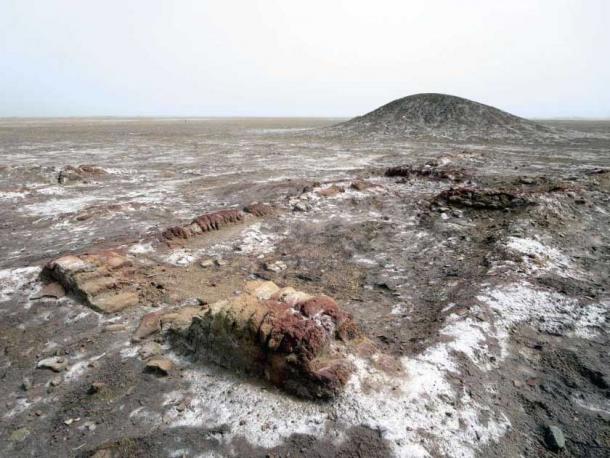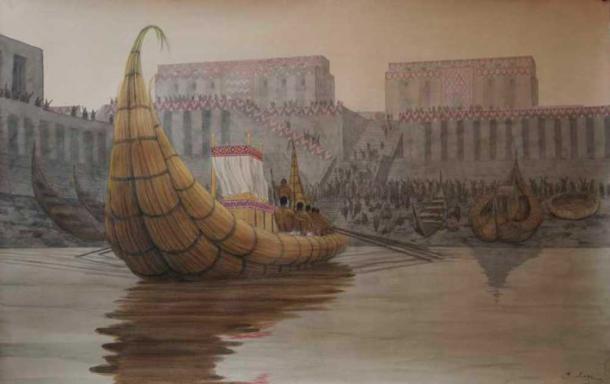
Drone Footage Reveals Lost Mesopotamian City Built on Marsh Islands
Using remote sensing data technologies at the site of one of the oldest urban centers in world history, scientists have identified a vast Mesopotamian settlement called Lagash. Once upon a time, Lagash consisted of four marsh islands interconnected by waterways. A flourishing, watery lifestyle existed almost 5,000 years ago, in this ancient wetland area located between the Euphrates and Tigris rivers in southern Iraq.
Drone Based and Other Technology
One of the participants of the project was Emily Hammer, an anthropological archaeologist from the University of Pennsylvania. Hammer employed a specially equipped drone that helped provide invaluable insight into Lagash, which formed the core of one of the world’s earliest states. The results of her work have now been published in The Journal of Anthropological Archaeology.
- Lagash, the Lost City of Mesopotamia
- 4,000-Year-Old Mesopotamian City Discovered In the Shadow Of Ur
After initial remote-sensing data gathered from the ground level, a drone was used to photograph the area around Lagash over six weeks in 2019. It took high-resolution UAV photographs of the site’s surface that aided Hammer’s research. She was also able to obtain magnetic gradiometry data.
The drone was aided by the heavy rains that had just ended around that time, leading to heavy salt absorption and salt moisture. These made detection of buildings, walls, streets, and waterways that were buried near ground level much easier as they surveyed the ancient Mesopotamian city of wetland islands.

Mud brick foundations and a ziggurat are among the remains of the 3rd millennium BC Sumerian city state of Lagash (Tell al Hiba) northeast of Nasiriyah, Iraq. (David Stanley / CC BY 2.0)
Raised Mounds, Surrounding Marshes
Lagash was likely founded between 4,900 and 4,600 years ago, and is today known as Tell al-Hiba. Excavated more than 40 years ago for the first time, it was learnt that this site was abandoned around 3,600 years ago. Previous analysis by other anthropologists, historians, and scientists indicate that Lagash was built on raised mounds in the marshes, and possibly consisted of 33 small, marsh islands. “There could have been multiple evolving ways for Lagash to be a city of marsh islands as human occupation and environmental change reshaped the landscape,” Hammer says.
Critically, Hammer’s study has helped challenge a traditional notion that has presented Mesopotamian cities as nuclear and compact settlements located within an irrigated agricultural hinterland. These settlements have been understood to have expanded from a singular monumental temple complex. Nevertheless, Lagash is different and the curious city of wetland islands has been found to be unlike this presupposed model.
Early Dynastic Lagash, dating back to around 2900 to 2350 BC, was made up of distinctly separate sectors, each with multiple walls or moat-like water courses surrounding them, interspersed by open spaces. In fact, Lagash is characterized by dense architecture spread out over 300 hectares (approximately). Evidence also points to marshy and watery local environmental factors. This led Hammer to conclude that the city sectors originated as marsh islands.
Drone photographs also point to harbors that potentially connected city sectors by boat travel. The remains of potential footbridges also emerged, though only excavations can shed further light on the subject, according to a report on Science News.

Like Lagash, Eridu in southern Iraq was once located within a lush area filled with freshwater marshes. (Public domain)
Absence of a Ritual and Geographical Center
An absence of a geographical or ritual center allowed each city sector to develop distinctive social and economic practices, to a certain extent. This is not dissimilar to the development of Venice, which evolved during a later historical time period.
Evidence of this was found at two of the marsh islands which were bordered by gated walls that had carefully laid out city streets and areas with large kilns. It was likely that crop growing and activities such as pottery making occurred here. On another island, waterways and canals crisscrossed each other, which likely suggests fishing and the collection of reeds for construction occurred.
In total, Hammer’s research points to three occupied islands near the Persian Gulf area, and a fourth one dominated by a huge temple. These islands were part of delta channels extending towards the sea, again reemphasizing the idea that Lagash was once a city of settled wetland islands which were interconnected by waterways.

The so-called cradle of civilization survived in what was once a lush, marsh-filled landscape, much like this imagined depiction of ancient Babylon. (Bazil Amin / CC BY-SA 4.0)
A Ceremonial Peak, An Unceremonious Decline
The drone also revealed evidence of contrasting neighborhoods on different marsh islands, which reflect either some kind of urban planning or a haphazard arrangement. The latter could be symptomatic of waves of migrations that occurred between 4,600 and 4,350 years ago, according to Augusta McMahon. McMahon was one of the three co-field directors of the continuing excavations at the site.
- Is Jiroft Site in Iran a True Cradle of Civilization?
- Saving Iraqi Mudhif Reed Architecture from Oblivion
These migrants were a mix of slave laborers captured from neighboring city states, mobile herders and residents from other cities and islands. At its peak, the city of wetland islands occupied four to six square kilometers (1.5 sq. mi.), which is the area equivalent to that of modern-day Chicago! It also housed tens of thousands of people during its heyday.
Just like other great historic cities, Lagash was doomed to collapse. In the end, it met its end when the marshy water levels fell due to a spike in temperatures. Since nearby cities continued to be occupied and inhabited for at least another thousand years, Lagash’s abandonment provides a window into a past that challenges the deeply held beliefs of what a Mesopotamian city looked like.
Top image: Remote sensing and drone footage of the Lagash / Tell al-Hiba site was deployed to conclude that the ancient Mesopotamian city was made up of four marsh islands. Source: Lagash Archaeological Project
By Sahir Pandey
















Comments
From the above photo caption, "Mud brick foundations and a ziggurat are among the remains of the 3rd millennium BC Sumerian city state of Lagash."
This is recognized pattern for the region, for post-Sumerian era. The Indus Valley might be best known for it, that is laying mud bricks OVERTOP megalith stone foundations. But here, we have to wonder how well mud bricks would serve in a marshlike, coastal environment. The original builders of the ‘ziggurat’ structure, chose stone, like the Atlanteans, certainly for its durability in a coastal/maritime setting. The problem for the Sumerians was they chose the low-quality expedient of mud bricks, perhaps not knowing how to replicate the stone masonry of the former culture/Atlantean-era aboriginals, who were of course decimated some 110k years earlier as Plato described (when you add back the zero to his timeline).
Nobody gets paid to tell the truth.